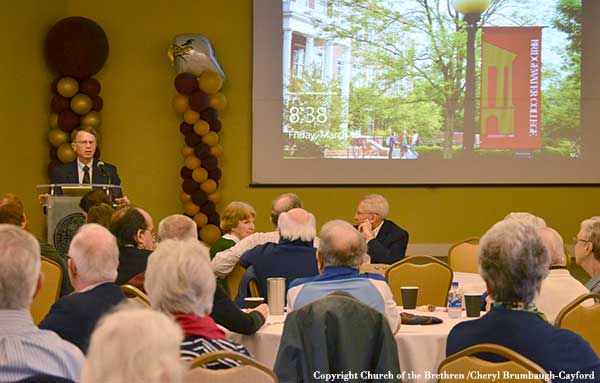
“The Status of Brethren Organizations: Demise and Momentum 1994-2019″ was the topic of the Bridgewater (Va.) College Forum for Brethren Studies on March 15. The day-long forum featured speakers on four institutions in the Church of the Brethren: Bethany Theological Seminary, Annual Conference, Brethren Press, and the Mission and Ministry Board.
The previous evening Robert P. Jones, CEO of the Public Religion Research Institute (PRRI), was the featured speaker for an endowed lecture. At the start of the forum he presented a question and answer session.
Jones set stage for forum
Jones’ lecture on “The Changing Religious Landscape in America” was sponsored by the college’s Center for Engaged Learning and Anna B. Mow Symposium on Comparative Religious Ethics. His conversation with the forum focused on shifts of population and ethnic make-up in the nation, the loss of young people in the church, Americans who are unaffiliated with institutional religion, changing expectations for the church, and effects of politics on religion in the US, among other topics.
Returning to points made in his popular book, “The End of White Christian America,” Jones said that the demographic shifts that are underway make for a brand-new situation in the nation and are a factor in the current political divides that also are affecting the church. He shared the metaphor of the “captain’s chair” at the head of the family table, traditionally the father’s seat. At the religious community’s “family table,” white Protestants have sat in that chair to date. But there is a new dynamic in which no one religious or ethnic group “owns” that chair. As a result, strong forces are pushing “tribalism” in an effort to seize control of the religious landscape. Resulting questions include: What does it mean to be Christian? And who gets to decide?
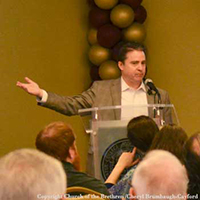
All white Christian denominations in the US are in decline, Jones said, speaking out of his organization’s well-respected research of American religion. Black churches are holding steady in terms of membership, while Latino and ethnically Asian and Pacific congregations are growing. The ranks of the religiously unaffiliated are growing as well.
Jones’ remarks touched on many controversial topics, including underlying reasons for the loss of young people in white American churches. This is connected to their perception of theology and church doctrine as irrelevant, the politicization of evangelical churches, and changing attitudes about sexuality, he said. “The civil rights issue of millennials is gay rights, and transgender rights…. It has become a test for how they see the church,” he said, adding that research finds 85 percent of Americans under the age of 30 support same-sex marriage.
All of this means that churches have to approach the rising generations “afresh,” he told the forum. The Church of the Brethren and other peace churches actually have an advantage, because the generations under age 40 share many of the same values, he said. “There are some Brethren distinctives that are quite resonant…justice, peace, simplicity,” he said. However, “there is a kind of branding problem,” he said, adding that the perception of whether a church lives out its values is a top concern for young people. An additional advantage for the Church of the Brethren may be counter-intuitive: “being an under-the-radar denomination” about which young people and the religiously unaffiliated may not have preconceived notions.
He drew attention to some opportunities for the church in the current situation: to offer pastoral care for those grieving losses in their shrinking congregations, and to make healing connections across boundaries of race. His own home church is the white half of a Southern Baptist congregation that split into black and white congregations after the Civil War. Now the pastors of those two separated churches are beginning to meet together again. He commented, “We’ve been waiting for generations to have this conversation.”
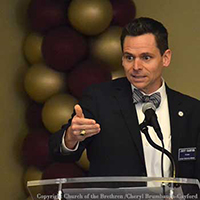
Respondent and current Bethany president Jeff Carter 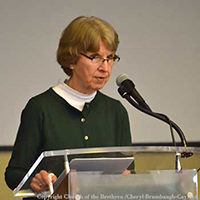
Bethany Seminary past president and presenter Ruthann Knechel Johansen
Bethany Seminary
Past president Ruthann Knechel Johansen spoke about Bethany Seminary, with current president Jeff Carter as respondent.
Johansen titled her remarks “The Dangers of a Single Story,” saying that “what is momentum to some, others may interpret as demise. What some perceive as harbingers of death, others perceive as possibility.”
In a detailed review of events, recollections, and interpretations of Bethany’s recent decades–particularly since its move from the Chicago area to Indiana–she identified strengths of the seminary as well as concerns. Strengths lie in the teaching faculty, cost effective education, commitment to Brethren values, ministry formation, financial stability, new certifications, among others. There are concerns in declining enrollment, aging donor base, insufficient support from congregations and districts, among others.
She found tensions and also possibilities for re-imagining theological education. For example, since the move to Richmond and accompanying relationship with Quaker educational institutions, the seminary has built an impressive faculty and new ministry training opportunities. Creation of the Brethren Academy for Ministerial Leadership is just one result. “Demise and momentum danced together” in Bethany’s recent history, Johansen said.
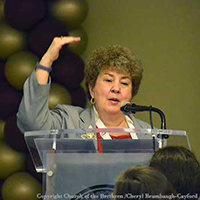
Respondent and Conference director Chris Douglas 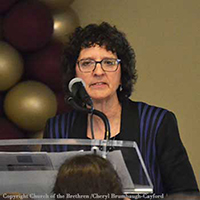
Bridgewater professor and past Annual Conference moderator Carol Scheppard
Annual Conference
Past moderator Carol A. Scheppard spoke about Annual Conference, with director Chris Douglas as respondent.
Scheppard asserted that the annual meeting, as the oldest of Brethren institutions, still holds the “DNA of the Brethren identity” but stands at a threshold in regard to its future. Challenges include shrinking finances, attendance, support, and delegate representation.
The core of her remarks came in an analysis of historical shifts in the practical function and nature of the annual meeting since its beginnings. The first annual meeting was held to discuss a tour by Count Zinzendorff that was perceived as enticing Brethren into what Scheppard characterized as an ecumenical movement, and its outcome was church leaders encouraging Brethren not to lose their distinctive practices. The annual meeting started as a consultative body with an informal structure and an emphasis on unity of practice. Over the centuries, it shifted into a legislative body with a formal structure. It started as a way of stemming innovation, but as time went on “the work of Annual Conference became more complicated,” she said.
With the compelling vision process, she said, the denomination is now coming to Annual Conference seeking innovation rather than its established function of stemming innovation. Her presentation allowed the question of whether the annual meeting can do both. Annual Conference, she said, has been a body “standing strong while allowing subtle changes…allowing bending with the winds of change.”
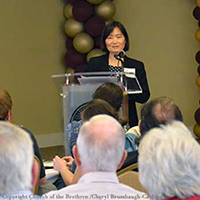
Brethren Press publisher Wendy McFadden 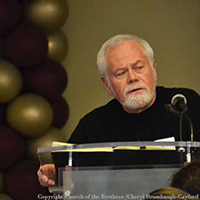
Bethany Seminary professor Scott Holland
Brethren Press
Scott Holland, Bethany’s Slabaugh Professor of Theology and Culture, spoke about Brethren Press, with publisher Wendy McFadden as respondent.
“Writing Among the Ruins: Brethren Press as a Prophetic, Poetic, and Pragmatic Ministry,” was the presentation’s title, as Holland talked about the publishing house during a time of continuing decline in church membership. If Brethren leadership hopes to turn the tide from demise to momentum, it needs to “lean into” a prophetic posture and a pragmatic ministry. He identified Brethren Press as doing both.
Brethren publishing since it started in 1851 has been linked with the development of denominational ministries. But Holland also listed many of the same institutional challenges named by previous speakers, as well as challenges particular to publishing: declining denominational loyalty, competition from other publishers, demand for more frequently updated curriculum, pressure to provide digital content, and demand for translations into more languages.
If denominational publishing is central to denominational identity, he asked, what might Brethren Press do to discern, invite, and encourage “the coming church” of the future? “There is an admirable momentum about Brethren Press even in the midst of the ruins,” he said, but its future hinges on the question: what is Brethren identity in the 21st century?
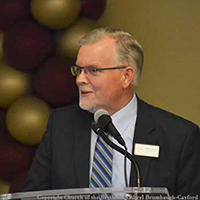
Church of the Brethren general secretary David Steele 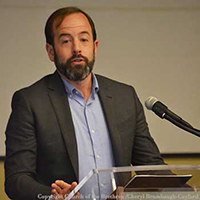
Ben Barlow, a past chair of the Mission and Ministry Board
Mission and Ministry Board
Past board chair Ben Barlow spoke about the Mission and Ministry Board, with Church of the Brethren general secretary David Steele as respondent.
Barlow began by sharing an image he saw in a dream: Elephants were raising a tent on a fairground, and with each was a group of Brethren representing a segment of the church. The groups and their elephants were pulling ropes to raise the tent. They worked together for awhile but then, worried that the tent would not be big enough for all, each group started to work harder to get their contingent inside–with the result that they ripped the tent to pieces.
Barlow focused his remarks on this struggle over a central Brethren identity, linking it with the history of the denomination’s boards. Brethren often “don blinders” when looking at the mix of identities and histories in the church, he said, examining examples of competing Brethren identities, such as Anabaptist and Pietist. He warned that the word “Brethren” does not mean the same thing to different members of the church, However, he said, “wherever they are on whatever spectrum you draw, there are the true Brethren.”